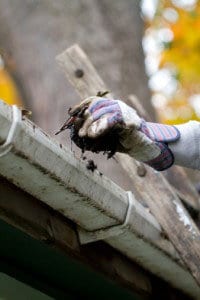Six Home Maintenance Essentials For Fall
 Fall snuck up on us pretty fast this year, so that means winter can’t be far behind. With the change of seasons, it’s a good reminder that there are some essential fall home maintenance tasks that every homeowner should put on their to-do lists. These steps will keep your home looking its best all season long, save energy and help prevent wear and damage throughout our long Wisconsin winter.
Fall snuck up on us pretty fast this year, so that means winter can’t be far behind. With the change of seasons, it’s a good reminder that there are some essential fall home maintenance tasks that every homeowner should put on their to-do lists. These steps will keep your home looking its best all season long, save energy and help prevent wear and damage throughout our long Wisconsin winter.
INSPECT YOUR ROOF
Take a good look at your roof. Do you see any loose or missing shingles? Notice any hail strikes from summer storms? Maybe you notice some of your shingles curling or looking noticably worn. The ice, wind and snow of winter will only compound this existing damage. It’s best to check out your roof in fall when repair or replacement is still feasible. Don’t forget – we’re here to help and offer free, no-obligation inspections.
CLEAN GUTTERS

Trees in your yard help shade your home during summer and provide beautiful colors during the fall, but when the leaves finally fall, they can plug up your gutters. This prevents them from shedding water from your roof and away from your foundation effectively. Even worse, clogged gutters in winter can lead to bigger problems like ice dams. Clean them out thoroughly and flush them with water to make sure downspouts are draining properly. This will ensure that melting snow in winter won’t pool up in the gutter and downspouts and freeze up. While you’re cleaning your gutters, it’s a good time to inspect them for damage, seal any cracks or undone joints, tighten up brackets or replace any sections that are past their prime.
THINK WARM THOUGHTS
A little preventative maintenance now will keep you from being left in the cold when winter comes. Schedule a checkup on your furnace to keep it running smoothly. Replace furnace filters to keep it running efficiently as well. If you still have an older thermostat, maybe this is the year to consider upgrading to a programmable model. They help with energy efficiency, and smart thermostats offer added benefits like remote setting over the Internet on smartphones.
It’s also a good idea to check out your fireplace, whether it’s the traditional wood-burning kind or a gas insert. If yours burns wood, have your chimney swept to ensure safe use throughout the season. Now’s also a good time to check out all your fire prevention devices like smoke alarms and fire extinguishers as well. Better safe than sorry!
If you have ceiling fans, switch the rotation to create an updraft to bring the warm air from the ceiling back down into the living space.
You may want to consider having a home energy audit, especially if you have an older home. It may identify places where you’re leaking heat and can add insulation.
CAULK AROUND WINDOWS AND DOOR FRAMES
This is one of the simplest, least expensive fixes you can do before winter, and you’d be surprised what a difference it can make. Caulking gaps around windows, door frames or other exposed joints can prevent heat from escaping and nasty cold drafts. Check any existing caulked joints too. If old caulk is breaking down, scrape it out and put new caulk in its place. Do this task sooner rather than later, as some caulk requires a minimum temperature of 40 degrees to set up properly.
While you’re caulking around the house, check for any exposed cracks, joints or other possible entry points for rodents. When the weather turns cold, mice and rats often look to your home for shelter and food sources. Mice can squeeze through openings the size of a pencil eraser! Use caulk to seal smaller areas, or stuff steel wool in larger gaps.
PREVENT PIPES FROM FREEZING
Last year was a particularly cold winter. It was so cold, even city water pipes into some homes froze up! A frozen pipe bursting can cause a lot of damage, but a few simple precautions can prevent this catastrophe. Remove and drain all hoses from outdoor faucets before overnight temperatures reach the freezing point. If you have indoor shutoffs for your outdoor faucets, turn them off and drain any remaining water from them. It’s a good idea to do this even if you have “frost-proof” faucets. Foam faucet covers are inexpensive and provide an extra layer of protection from bitter winter winds.
If you plan to travel and turn down your thermostat to save energy, make sure you leave your heat set to at least 55 degrees to ensure pipes in your basement don’t freeze up.
CLEAN UP OUTDOOR SPACES
Snow and ice take their toll on outdoor spaces, so it’s a good idea to check out other areas of your yard that may be vulnerable during the winter months. Check your siding and soffits for peeling paint and repaint any of those areas to keep them protected. Check out your deck for cosmetic or structural problems, and cover any deck furniture or grills that may need protection. Empty planters or pots to prevent cracking when water freezes and expands. Cover your air conditioner to prevent damage from snow and falling ice from roofs.
Check out your driveway or other paved surfaces, patch any cracks or holes and seal them to keep them protected from the elements.
Turning to the garage, now’s the season to maintain any yard equipment. Clean and winterize any warm-weather equipment, and prepare snowblowers and other winter maintenance gear for the season ahead. You don’t want to find yourself scrambling before that inevitable early-season blizzard! You may also want to check out weatherstripping on your garage door, and bring containers of freezable liquids like paint indoors.



